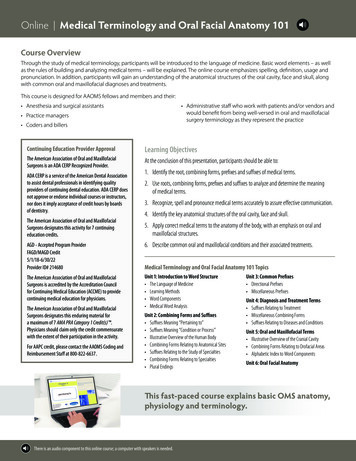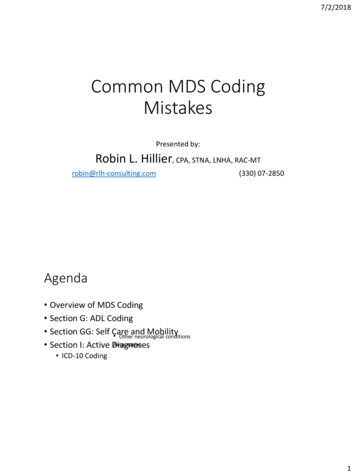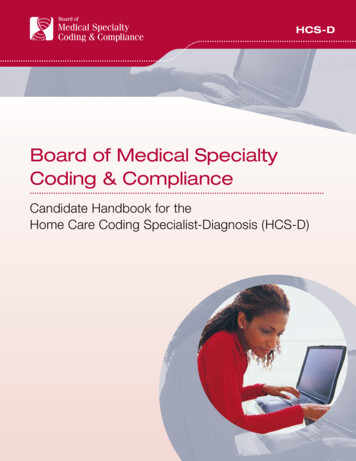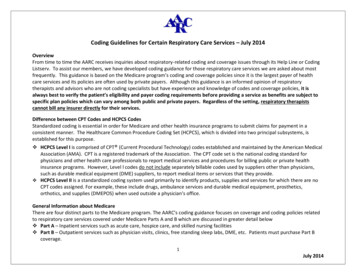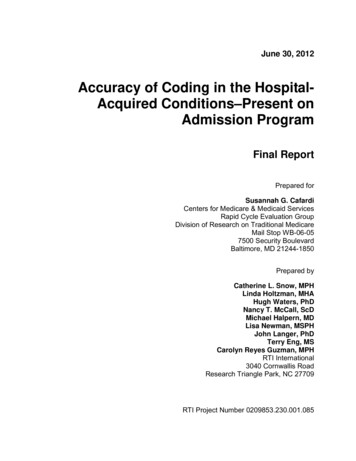
Transcription
June 30, 2012Accuracy of Coding in the HospitalAcquired Conditions–Present onAdmission ProgramFinal ReportPrepared forSusannah G. CafardiCenters for Medicare & Medicaid ServicesRapid Cycle Evaluation GroupDivision of Research on Traditional MedicareMail Stop WB-06-057500 Security BoulevardBaltimore, MD 21244-1850Prepared byCatherine L. Snow, MPHLinda Holtzman, MHAHugh Waters, PhDNancy T. McCall, ScDMichael Halpern, MDLisa Newman, MSPHJohn Langer, PhDTerry Eng, MSCarolyn Reyes Guzman, MPHRTI International3040 Cornwallis RoadResearch Triangle Park, NC 27709RTI Project Number 0209853.230.001.085
Accuracy of Coding in the Hospital-Acquired Conditions—Present on Admission ProgramFinal Reportby Catherine L. Snow, MPH; Linda Holtzman, MHA; Hugh Waters, PhD;Nancy T. McCall, ScD; Michael Halpern, MD; Lisa Newman, MSPH;John Langer, PhD; Terry Eng, MS; Carolyn Reyes Guzman, MPHFederal Project Officer: Susannah G. CafardiRTI InternationalCMS Contract No. HHSM-500-2005-00029IJune 30, 2012This project was funded by the Centers for Medicare & Medicaid Services under contract no.HHSM-500-2005-00029I. The statements contained in this report are solely those of the authorsand do not necessarily reflect the views or policies of the Centers for Medicare & MedicaidServices. RTI assumes responsibility for the accuracy and completeness of the informationcontained in this report.RTI International is a trade name of Research Triangle Institute.
CONTENTSEXECUTIVE SUMMARY .1ES.1 Methods.1ES.2 Data .2ES.3 Results .3SECTION 1 INTRODUCTION AND BACKGROUND ON ACCURACY OF CODING .71.1 Objectives .71.2 Selected Phase II Conditions for Medical Record Validation .71.3 Conceptual, Operational, and Clinical Definitions of Accuracy of Coding .81.3.1 Conceptual Definition of Accuracy of Coding .81.3.2 Operational Definitions of Accuracy of Coding .91.3.3 RTI Physician Review for Accuracy of Coding .10SECTION 2 SAMPLING DESIGN.112.1 Sampling Plan .112.1.1 Measures of Interest .112.1.2 Estimated Magnitude of the Parameters .112.1.3 Margin of Error and Confidence Intervals .122.1.4 Sample Size Requirements for Medical Record Abstraction .122.2 Sampling Frame .132.3 Medical Record Sampling Plan .132.3.1 Linking CERT Medical Records to MedPAR Data.132.3.2 Sampling Plan for Assessing Accuracy of POA Coding .142.3.3 Sampling Plan for Assessing Accuracy of HAC Coding.14SECTION 3 MEDICAL RECORD VALIDATION PLAN .173.1 Medical Record Validation Flow Diagrams .173.2 Medical Record Abstraction Tools .193.2.1 Type of Review .203.2.2 Preliminary Evidence .203.2.3 Part I—Should the Listed Condition Be Coded? .203.2.4 Part II—Was the Listed Condition Present on Admission? .213.2.5 Disposition .213.3 Medical Record Validation Process .213.4 RTI Institutional Review Board .22iii
SECTION 4 DATA ANALYSIS .234.1 Unreported HAC Observations .234.2 Over-Reported POA Observations .254.3 Strength of Evidence for POA .274.4 Abstraction Observations .284.4.1Physician Queries Related to Potential HACs .284.4.2Pressure Ulcer Coding .30SECTION 5 DISCUSSION .31REFERENCES .35APPENDIX A: ASSESSMENT OF THE REPRESENTATIVENESS OF THE CERTRECORDS .36APPENDIX B: APPENDIX OF TOOLS .45APPENDIX C: CLINICAL CODING GUIDELINES .63LIST OF FIGURESFigure 1-1Figure 3-1Figure 3-2Conceptual definition of the accuracy of coding . 8Unreported HACs: Medical record validation flow diagram . 18Over-reported POA: Medical record validation flow diagram . 19LIST OF TABLESTable ES-1Table ES-2Table 2-1Table 4-1Table 4-2Table 4-3Table 4-4Table 4-5Table 4-6Table 4-7Table 4-8Summary of HAC coding accuracy: CAUTI, VCAI, DVT/PE . 3Summary of POA coding accuracy: All five POA conditions combined . 4Sample sizes for each condition. 12Summary of HAC coding accuracy: CAUTI, VCAI, DVT/PE . 23Number of unreported HAC cases determined to be present on admission forthree clinical conditions: CAUTI, VCAI, DVT/PE . 24Number of cases where condition was present and how it affected patient careor three clinical conditions: CAUTI, VCAI, DVT/PE. 24Number of cases stratified by level of evidence that the unreported HAC caseswere present for three clinical conditions: CAUTI, VCAI, DVT/PE . 25Summary of POA coding accuracy: All five POA conditions combined . 25Over-reported POA: number of cases where the condition was present, but noton admission, or was not present at all . 26Over-reported POA: POA summary of evidence . 27Over-reported POA: POA pressure ulcer evidence . 28iv
EXECUTIVE SUMMARYUnder the Hospital-Acquired Conditions—Present on Admission (HAC-POA) program,accurate coding of hospital-acquired conditions (HACs) and present on admission (POA)conditions is critical for correct payment. The purpose of the HAC-POA program, funded by theCenters for Medicare & Medicaid Services (CMS), is to evaluate the HAC-POA payment policyrelated to preventable HACs. The principal objective of the Accuracy of Coding component,which is the subject of this report, is to determine the level of accuracy of coding for HACs andfor POA conditions. This study was conducted jointly by RTI International and Clarity Coding.For payment purposes, for each condition there are two questions that are key toassessing the accuracy of coding:1. Is there documented clinical evidence that a condition was present during thehospitalization? We identified unreported cases, where a HAC-associatedcondition existed but was not reported by the hospital.2. If yes, was the condition POA?We identified over-reported POA cases, where a HAC-associated secondarydiagnosis code was reported as POA when it was not in fact POA.After considering a wide range of data sources and discussing priorities with the projects’funders, we focused on three types of POA s for examining under-reporting:1. Catheter-associated urinary tract infections (CAUTI),2. Vascular catheter-associated infections (VCAI),3. Deep vein thrombosis/pulmonary embolisms (DVT/PE); andfive types of HACs for examining POA over-reporting:1. CAUTI ,2. VCAI,3. Falls and trauma,4. Stage III and IV pressure ulcers, and5. Extreme manifestations of poor glycemic control.ES.1MethodsClarity Coding, under subcontract to RTI, abstracted medical records to confirm if caseswere correctly coded for both HAC and POA status. Our operational definition for accuracy ofcoding is based on diagnostic and procedural information about the patient as coded and reported1
by the hospital on the claim form, matched against the documentation in the patient’s medicalrecord, while factoring in relevant coding guidelines from definitive sources.We selected claims included in the Fiscal Year (FY) 2009 and FY 2010 MedicareProvider Analysis and Review (MedPAR) file that had one or more of the five HAC-associateddiagnoses coded as POA. We also included records of patients that did not have a HAC coded,but were at risk of developing the condition (e.g., had an indwelling urinary catheter, centralcatheter, or certain orthopedic procedures). We merged these MedPAR data with medicalrecords—obtained by CMS through its Comprehensive Error Rate Testing (CERT) program.To assess accuracy of HAC and POA coding, a coding expert reviewed the full medicalrecord for each case. The Clarity Coding coder would make a technical coding change withoutphysician review if the medical record clearly stated that the condition presented during thehospitalization but the wrong diagnosis code was used by the hospital. If the coders were unableto make a decision due to clinical ambiguity, they referred the case to an RTI physician forreview and decision. Linda Holtzman, MHA, was the Clarity Coding Project Director for thisactivity, supervising a team of four coders.ES.2DataThrough a combination of training, monitoring, and inspection, RTI and Clarity Codingprovided a high level of data protection and quality control. CMS staff provided us with the FY2009 and FY 2010 medical records received by the CERT program, including the informationnecessary to link these medical records to Medicare claims data. After excluding those hospitalsnot subject to the Medicare Inpatient Prospective Payment System (IPPS)—and therefore notsubject to the HAC-POA policy—our sampling frame was 10,465 unique CERT medicalrecords. Using beneficiary and hospital identification information in the medical records, welinked the records to the MedPAR claims data for FY 2009 and FY 2010. This step allowed usto create an electronic database linking claims data to the medical records, and populating thedatabase with information from the MedPAR claims, including diagnosis codes, procedurecodes, and other data elements that might be useful for our analyses.To ensure that the CERT records were representative of all Medicare IPPS discharges,we compared characteristics of the CERT medical records to the characteristics of all dischargesfrom IPPS hospitals in the FY 2009 and FY 2010 MedPAR database. We verified that thedistributional properties of the CERT records are consistently similar to the MedPAR records forpatient and hospital characteristics such as patient age, gender, race, principal diagnoses, andhospital size and location. (For a more detailed analysis of the representativeness of the CERTrecords, please refer to Appendix A.)We sought to have 264 CERT records for assessing accuracy of reporting HACs for eachof the three selected conditions. To identify VCAI records for validation, we screened MedPARrecords with a central line or venous catheterization coded as having been inserted during thehospitalization—excluding records where VCAI was coded as hospital acquired (POA N or U)or present on admission (POA Y or W). This yielded 881 CERT records; a random sample of264 was selected.2
CERT medical records for DVT/PE validation were selected by identifying MedPARrecords with corresponding claims that did not have DVT/PE coded as hospital acquired or POA,but did have certain orthopedic procedures with a high risk for developing DVT/PE (hipresurfacing, hip replacement, and knee replacement)—for a total of 222 CERT records. Whilethis was less than the 264 desired for coding review, there were no additional discharges inwhich the patient had undergone one of these orthopedic procedures.For CAUTI cases, we first identified MedPAR records that linked to CERT records andhad the presence of an indwelling urinary catheter coded, excluding any MedPAR cases whereCAUTI was coded as hospital acquired (POA N or U) or present on admission (POA Y orW). This produced 90 CERT records for review. Next, MedPAR records were linked with theircorresponding physician claims to identify cases where a physician billed for insertion ofindwelling urinary catheter during the inpatient stay. This yielded an additional 35 CERTrecords for review. And, third, RTI staff manually screened the CERT records for the presenceof an indwelling urinary catheter. Of 308 cases screened, 139 had evidence that the beneficiaryhad an indwelling catheter inserted at some time during the hospital admission. Of these, onerecord could not be read, leaving a total of 263 CERT records.To test for POA status, we selected all CERT records that had one of the 12 HACs codedas POA on its linked MedPAR claim. This process yielded a total sample of 318 cases acrossfive conditions: CAUTI (13), VCAI (5), Stage III or IV pressure ulcers (105), falls and trauma(181), and extreme manifestations of poor glycemic control (14).ES.3ResultsWe did not find patterns of widespread under-reporting of HACs or over-reporting ofPOA status. In just 23 out of a total of 749 HAC cases (3%), the condition was determined to bepresent but not reported. Of the disagreements that were observed, the most frequent were forCAUTI cases, 6% of which were inaccurately coded (i.e., the condition was present but notcoded by the hospital). The least frequent disagreement was for DVT/PE cases, with noinaccurately coded HACs (Table ES-1). For 17 of 23 HAC cases, the condition was POA. Thisleaves just 6 of the 749 cases that were both hospital acquired and inaccurately coded.Table ES-1Summary of HAC coding accuracy: CAUTI, VCAI, DVT/PEDispositionCAUTI CAUTIn%VCAInVCAI%DVT/PE DVT/PEn%Hospital coded/reported accuratelyHospital did not Total263100%264100%222100%NOTE: CAUTI, catheter-associated urinary tract infection; DVT/PE, deep veinthrombosis/pulmonary embolism; HAC, hospital-acquired condition; VCAI, vascular catheterassociated infections.3
The results for over-reported POA cases are similar in magnitude. Of all the cases codedPOA, 91% were coded accurately (Table ES-2). However, the level of uncertainty around thisestimate is large, given the small number of CERT medical records available for abstraction. Ofthe 28 POA cases coded inaccurately, the highest percentages are attributable to Stage III and IVpressure ulcers, with 9% (9 out of 105 cases) being incorrectly reported as POA; and falls andtrauma, with 8% (14 out of 181 cases) incorrectly reported as POA.Table ES-2Summary of POA coding accuracy: All five POA conditions combinedDispositionHospital coded/reported accuratelyHospital did not code/report accuratelyTotalN%2902831891%8%100%NOTE: POA, present on admission.When evaluating medical records coded by the hospital as the condition being POA, thecoders looked for two things: (1) whether the condition existed during the stay, and (2) whetherthe condition was POA. This approach allowed for two ways in which the Clarity Coding codercould disagree with the hospital coder. From the cases reviewed in this study, the former seemedto be the main reason for coder disagreement; 23 out of 28 inaccurately coded POA cases wereinaccurate because the condition was not present at the time of admission or at any time duringthe hospitalization.Clarity Coding was asked to provide RTI with their observations from the detailedmedical record reviews they performed. They noted that two specific types of cases wereparticularly challenging: unreported CAUTI and over-reported POA pressure ulcers. Theyprovided specific cases illustrating that two coding issues identified may affect interpretation ofthe validation results: a lack of physician queries in the medical records, and the requirement tocode progression of pressure ulcers to Stage III or IV during the hospitalization as POA. Thecoders found numerous instances in which the hospital coding was in accordance with codingguidelines, but the conditions might have been perceived as hospital acquired by cliniciansunfamiliar with coding practices. Using exclusively clinical validation criteria not requiringconformance with official coding guidelines, more instances of under-reporting of HACs orover-reporting of POA may have been found. However, from a coding perspective theconditions could not be determined to be hospital acquired. Coding is fundamental toadministration of the HAC-POA program, and its requisites must be observed.With respect to progression of pressure ulcers to Stage III or IV during thehospitalization, coding guidelines direct that the Stage III or IV pressure ulcer be confirmed asPOA if a lower stage ulcer was recognized on admission and progressed to a higher stage ulcerduring the admission. CMS may wish to discuss the unintended consequences of codingguidelines on the HAC-POA payment policy with the other Cooperating Parties.4
The inconsistency in how hospitals store queries creates issues with accessing them. Thiscan impede any type of external coding review and inadvertently skew its findings. If possible,hospitals should be urged to uniformly include all queries and their responses as part of thepermanent medical record. This would ensure that a complete clinical picture is available toreviewers and can be reflected in their findings.5
[This page left intentionally blank]6
SECTION 1INTRODUCTION AND BACKGROUND ON ACCURACY OF CODING1.1ObjectivesThe purpose of this project, funded by the Centers for Medicare & Medicaid Services(CMS), is to evaluate the Hospital-Acquired Conditions–Present on Admission (HAC-POA)payment policy related to preventable hospital-acquired conditions (HACs). This policy is oneof several recent CMS value-based purchasing initiatives designed to improve the structure ofpayment incentives aimed at improving health care performance. Accurate coding of HACs isessential for these payment incentives to be effective—as is correctly identifying whether HACassociated conditions are present on admission (POA) rather than acquired in the health caresetting.The principal objective of the Accuracy of Coding component of the HAC-POA Projectis to determine the level of coding accuracy for HACs and for POA conditions. Throughmedical record abstraction, we have evaluated the degree to which independent coders validatedhospitals’ coding of conditions that are hospital acquired and those that are POA. This study wasconducted jointly by RTI and Clarity Coding.1.2Selected Phase II Conditions for Medical Record ValidationRTI worked with the project’s funders to identify the Phase II conditions for the study.The funders provided key inputs for this process, including information and recommendationsregarding the selection of HACs, examples of algorithms for assessing the accuracy of coding,feasibility of case identification, relevant literature, and, when physician reviews were necessary,which data elements to consider including in these reviews. For Phase II, we focused onassessing the accuracy of coding of three types of HACs: (1) catheter-associated urinary tractinfections (CAUTI); (2) vascular catheter-associated infections (VCAI), also described as centralline-associated bloodstream infections (CLABSI); and (3) deep vein thrombosis/pulmonaryembolisms (DVT/PE). CAUTI was identified by the Office of the Inspector General (OIG) as apriority condition in terms of incorrect coding and reporting. The CDC suggested VCAI forconsideration—and provided a computer algorithm to use as a template in developing ourabstraction tool (Trick et al., 2004). DVT/PE was selected as a clinical condition for the studybecause of strong, objective confirmatory diagnostic testing readily available for patientspresenting with symptoms of either DVT or a PE.As discussed in more detail below, we identified 10,465 medical records—obtained byCMS from its Comprehensive Error Rate Testing (CERT) program. However, when we mergedthese CERT records with the Fiscal Year (FY) 2009 and FY 2010 Medicare Provider Analysisand Review (MedPAR) records that had one or more of the HAC-associated diagnoses coded asPOA, we obtained only 318 matches. The project’s funders therefore determined that all CERTrecords that matched a MedPAR record with a relevant POA code would be abstracted. Thefollowing five conditions had matching CERT records and so are the subject of our assessmentof accuracy of POA coding: (1) CAUTI, (2) VCAI, (3) falls and trauma, (4) Stage III and IVpressure ulcers, and (5) extreme manifestations of poor glycemic control.7
1.3Conceptual, Operational, and Clinical Definitions of Accuracy of Coding1.3.1 Conceptual Definition of Accuracy of CodingUnder CMS’s HAC-POA program, hospitals have financial incentives to record clinicalconditions as POA—for example, a history of a DVT following a prior orthopedic procedure.Hospitals also potentially have incentives to mischaracterize or under-report clinical conditionsthat are acquired during the hospitalization. For example, a hospital could label a Stage IIIpressure ulcer as a Stage II instead if the ulcer was acquired during the hospitalization, or label apressure ulcer as Stage III rather than Stage II if it is POA.Accurately coding HACs and POA conditions is critical for correct payment under theHAC-POA program. For payment purposes, for each condition, two questions are key toassessing the accuracy of coding:1. Is there documented clinical evidence that the condition was present during thehospitalization?2. If yes, was the condition POA?This task looks at how accurately hospital coders reported the answers to these twoquestions on claims submissions. Figure 1-1, below, provides a conceptual framework.Figure 1-1Conceptual definition of the accuracy of codingPOAPOAAccurately CodedCondition ExistedCodedNot POACoded as POACondition did not ExistHAC - AssociatedDiagnosis CodeInaccurately CodedInaccurately CodedPOACondition ExistedInaccurately CodedNot CodedNot POACondition did not ExistAccurately CodedFor each condition, the first question is whether a HAC-associated diagnosis was codedon the claim, as shown in the far left box of Figure1-1. Following the path in the lower section8
of the figure, a “Not Coded” leads to the possibility of either incorrect coding (coded that thecondition did exist) or correct coding (coded that the condition did not exist). This study focuseson whether a condition not coded by the hospital did exist, resulting in an inaccurately codedcase as illustrated in the diagram. To further understand what this kind of inaccurate codingrepresents, we looked at these cases to determine if they were POA or hospital acquired. Wefirst identified the total number of cases for which the coding was inaccurate—in other words,evidence that the condition existed during the hospitalization but was not coded. Secondly, weidentified which of these unreported cases should have been coded POA.At the top of Figure1-1, the HAC-associated diagnosis is correctly coded, and theconcern is the accuracy of POA coding. POA can be over-reported in two ways. The first iswhen the condition is coded as POA, but was in fact hospital acquired. The second type of overreporting occurs when the condition is coded and reported as POA, but the condition itself didnot actually exist during the stay. Both conditions are presented in the top half of Figure 1-1, andwe analyze both when we assess the accuracy of POA coding.To summarize, this study focuses on two types of coding inaccuracies: HAC-associated secondary diagnosis code is not coded but the condition existedduring the hospital stay; and HAC-associated secondary diagnosis code is coded and reported as POA when it wasnot POA.1.3.2 Operational Definitions of Accuracy of CodingRTI explored several alternatives for defining and measuring accuracy of coding in PhaseI, including literature reviews, discussions with the project funders, and conversations withcoding and other experts. Our operational definition of accuracy of coding is based ondiagnostic and procedural information about the patient as coded and reported by the hospital onthe claim form, matched against the documentation in the patient’s medical record, whilefactoring in relevant coding guidelines from definitive sources.We abstracted medical records to confirm if cases were correctly coded—based onclinical information documented by the responsible physicians and other qualified health careproviders. Cases were referred for review by an RTI physician whenever medical judgment wasneeded. If the Clarity Coding coder did not agree with the diagnosis code based on clinicaldocumentation and coding guidelines and felt confident that a diagnosis change was appropriate,the coder reported the case as coded incorrectly by the hospital. For example, if the physiciannarrative description states, “UTI due to indwelling catheter,” yet the diagnosis code reported bythe hospital was for a simple UTI, the Clarity Coding coder would make a technical codingchange without physician review.If the coders were unable to make a decision due to clinical ambiguity, they referred thecase to an RTI physician for review and comment. These referral cases included clinical ordiagnostic uncertainty as well as unclear or incomplete documentation. This type of HAC underreporting was identified by the 2010 report from the Inspector General of Health and Human9
Services on the topic of adverse events in hospitals—for cases in which “ physician reviewsdetermined that the beneficiary experienced a ‘catheter-associated urinary tract infection,’ yet thebilling data included a more general diagnosis code for ‘urinary tract infections, not otherwisespecified’” (Levinson, 2010).To assess accuracy of HAC and POA coding, the full medical records for these caseswere reviewed by a coder. While validating the coding, the coders also abstracted informationfrom the medical record, allowing us to develop categories of explanations, where possible, forover-reporting of POA cases and under-reporting of HAC cases.There may be instances of “false disagreement” between the hospital and the ClarityCoding coder that arose due to incompleteness of the medical record. The medical recordsobtained through the CERT program did not always include the physician query forms. Theseforms allow the physician to augment or clarify ambiguous documentation in the medical record.Although physician query forms are the approved means for clarifying documentation, theseforms are not consistently included in the formal medical record. Depending on the hospital, andsometimes on the physician, queries may be made in a nonpermanent form—for example, with asticky note—and responses may be documented in a query database and not included in themedical record. As a result, we may not have had complete physician query informationconsistently available as part of the medical record requested by the CERT program.Linda Holtzman, MHA, was the Clarity Coding Project Director for this activity; shesupervised a team of four coders. Ms. Holtzman and each of the coders are credentialed asCertified Coding Specialists (CCS), Registered Health Information Technicians (RHIT), orRegistered Health Information Administrators (RHIA). Ms. Holtzman is a CCS-P (specialized inphysician coding) and Certified Professional Coder specialized in hospital coding (CPC-H), aswell as an RHIA. She personally conducted validation coding and provided guidance on thedevelopment of the final validation tools and insights into validation findings.1.3.3 RTI Physician Review for Accuracy of CodingTwo kinds of physician assi
To assess accuracy of HAC and POA coding, a coding expert reviewed the full medical record for each case. The Clarity Coding coder would make a technical coding change without physician review if the medical record clearly stated that the condition presented during the hospitalization but the wrong diagnosis code was used by the hospital.




